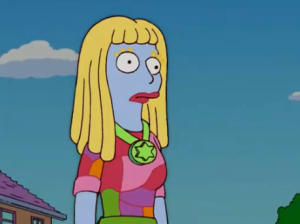In an episode of The Simpsons titled “Treehouse of Horror XVII,” the golem is awakened as a source of comedy. When Bart brings back Krusty’s Golem of Prague (whose design seems most similar to the design used in the German expressionistic film “The Golem: How he Came into this World”) he instructs him to come to his house at midnight so he can proceed to fulfill all his devious high school boy wishes. Similarly to in the German film, the golem begins to feel human emotions such as loneliness and despair so in order to remedy this Marge uses Play-Doh to create a female Golem, voiced by Fran Drescher who has a quintessential Brooklyn Jewish nasal voice.
Some questions/ ideas to comment on:
1.) A tree house suggests roots in the soil and also a place for child’s play, how does the title “Treehouse of Horror” work as a location for capture and lines of flight?
2.) How do you see the aesthetics of different golem representations as affecting their “humanity”?
3.) One of the differences, which stood out to me is the Simpsons’ response to the golem’s growing humanity. Rather than trying to strip this recently gained humanity from him, Marge makes him a female mate to help fulfill his desires.
4.) When the male golem is given the ability to speak he has the voice of a modern day, stereotypical “American Jew.” How is this also a critique on modern society? This comical take adheres closely to certain aspects of the golem as represented in Jewish folklore (scrolls, writing ,etc) yet he is obviously a product of modernity used for purposes distant from his original use.
5.) The female golem is made out of Play- Doh, a product of consumerist America alluding to capitalism and modernity. How does one come to see the present in terms of the past? Marge Simpson is also her creator. Who can create a golem and in what context? Originally a rabbi, who is considered the closest being to God, created the golem. How do you see Marge as taking this role? If she is taking the role of rabbi, it must be that a very different type of God is working here. After all, writers for The Simpson’s wrote and created Marge. Perhaps Marge’s God is that of comedy itself?
6.)Is this golem at all representative of its origins in oppression and excommunication that the golem was born out of? Is this important? If we know the past then can we understand where we are going?
7.) How can rewriting through comedy function as a way to dislodge stereotypes? I see the comic genre as having the potential for catharsis through its active engagement with captures in a manner that defamiliarizes the ordinary. Once given a voice, the Simpsons’ golem is extremely representative of the stereotypical, New York Jew. By overly exaggerating such a stereotype it becomes quite jarring and presents a conflict between that in reality which is perceived and that which is conceived. Doing so makes the audience much more aware of what they bring to the table from their own social location/ position. As a result, the trope of the golem and the stereotyped Jew can be seen more clearly as oversimplified generalizations that are too flat to possibly represent a person.

